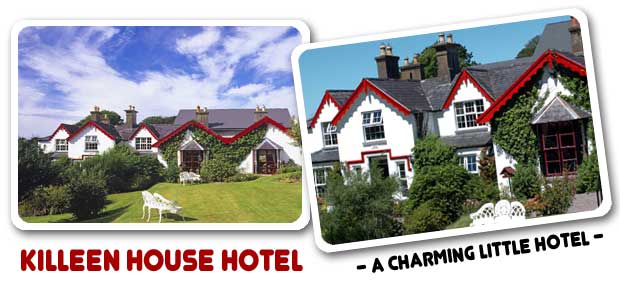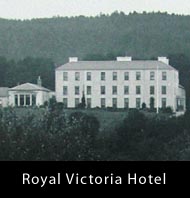Aghadoe House
Houses within 5km of this house
Displaying 19 houses.
Houses within 5km of Aghadoe House
Displaying 19 houses.
| House name | Description | |
|---|---|---|
| Summerhill (Mount Meredith) | In 1786 Wilson refers to Mount Meredith as a gentleman's seat close to Killarney. Bary writes that this is the property that later became known as Summerhill, held by The O’Donoghue. The Ordnance Survey Name Books note that this townland was leased by St. John Mason to Richard McGillycuddy and Madam O'Donoghue in the 1830s. The house is described as "formerly a handsome house but is now suffering to go to ruin". At the time of Griffith’s Valuation it was valued at £3 and leased to James Donovan. A substantial modern farm exists at the site now. | |
| Cleeny | At the time of Griffith’s Valuation, Maurice Brennan was leasing a property at Cleeny, valued at almost £7, from The O’Donoghue estate. In 1906 it was owned by Lord Kenmare's estate and valued at £5 15s. Modern farm buildings are located at the site. | |
| Coolgarriv House | James Donovan, MD, was leasing Coolgarriv House from The McGillycuddy’s estate at the time of Griffith’s Valuation, when it was valued at £12 10s. Bary, quoting the Ordnance Survey Name Books, states that Coolgarriv House was built by the Eager family in the 1830s at a cost of £900. It is still extant and occupied. | |
| Curragh House | Lady Headley’s estate was leasing a property valued at £6 5s to James Beazly at the time of Griffith’s Valuation. Bary states that the Beazlys acted as agents for the Headley estate and that Curragh House was built c.1810. The house underwent renovation in the later twentieth century. | |
| Aghadoe Cottage | Archdeacon Forester was leasing Aghadoe Cottage from the Headley estate at the time of Griffith’s Valuation when it was valued at £7 10s. Bary states that it was built by the Archdeacon in 1838 though the Ordnance Survey Name Books mention him as being in residence there before that. It is still extant and is now run as Killeen House Hotel. See www.killeenhousehotel.com |

|
| Gortroe Lodge | At the time of Griffith’s Valuation, Gortroe Lodge was being leased by John Morrogh Bernard from John C.O’Riordan when it was valued at £22. Lewis records Gortroe Lodge as the seat of S. Riordan. Bary states that, according to John O’Donovan, Stephen Riordan built Gortroe Lodge in 1831. The house is now demolished and much development has taken place in the area. | |
| Grenagh House | Denis Lawlor was leasing Grenagh House from Henry Herbert’s estate at the time of Griffith’s Valuation when it was valued at £23 15s. Lewis mentions Grena as the seat of John O’Connell in 1837. The Ordnance Survey Name Books indicate that it was built by Mrs. Delaney in 1792. Bary states that O’Connell was obliged to leave the house due to debts. It then came into the possession of Denis Shine Lawlor and later again, Daniel James. It was afterwards the property of the O'Connor family but has been ruinous since the mid twentieth century. | |
| Royal Victoria Hotel | Christopher Gallway was leasing this property to Thomas Finn at the time of Griffith’s Valuation, when it was valued at £65. This appears to be the Royal Victoria Hotel. In the early 1940s the Irish Tourist Association Survey noted that the Victoria Hotel "once the finest hotel in the district" had been converted into a farmhouse "about 130 years" and that there was an expectation that it was to be converted into a golf clubhouse. The site is now occupied by the Castlerosse Hotel, opened in 1960. |

|
| Killarney Mills | Christopher Gallway was leasing an extensive milling concern from the Kenmare estate at the time of Griffith’s Valuation. It was then valued at £85. Lewis refers to "the extensive flour-mills of Messers Galway and Leahy, worked by the river Dinagh" in 1837. Lyons notes that the mill complex was sold in the Encumbered Estates Court in 1855 and purchased by Richard Leahy for £1500. It was taken over by the Electricity Supply Board in 1940. The mills are no longer extant. |

|
| Lakeview | At the time of Griffith’s Valuation, James O’Connell was leasing the property from the Herbert estate when it was valued at £13. Lewis calls the house Lakeville in 1837. Leet also mentions a house called Lakeville in 1814 which he refers to as the residence of Francis Russell. Bary states that the existing house was built by James O’Connell in 1870 after he was made a Baronet but that there was an earlier house here also. The latter is mentioned as the residence of Mr. O'Connell in the Ordnance Survey Name Books of the 1830s. It was built in 1740 and located in the southern end of the townland. In 1894 Slater refers to Lakeview as the residence of Sir Maurice J. O'Connell. The house is still extant. |

|
| Ballydowny | Bary states that "Ballydowney is a very old house, probably built in the early 18th century. It was the house in which Robert Emmet, the patriot hanged in Dublin in 1803, was born. His mother was Elizabeth Mason". The Ordnance Survey Name Books record that the proprietor, St. John Mason, had leased the townland to Richard McGillycuddy in the 1830s. By the time of Griffith’s Valuation, the house was valued at £4 and being leased by Charles Daly from Daniel Cronin. In the early 1940s, the Irish Tourist Association Survey also refers to the possible association with Robert Emmet though it indicates that this story may refer to an earlier house, "replaced by the present one, built about a hundred years ago". In 1942 it was occupied by a Mr. Blanchfield and is still extant. | |
| Belview House | Arthur Mahony was leasing a property valued at almost £4 from the Kenmare estate at the time of Griffith’s Valuation. In 1906 it was part of the Kenmare estate and valued at £5 5s. Bary states that this house, very close to the lake shore, was built by James Mahony, of the Dunloe Castle family, in the latter half of the 18th century. In the 1930s, it was still part of the Kenmare estate and Lord Castlerosse supervised the building of Killarney Golf Club here. The original house was demolished to make room for a new clubhouse. | |
| Killarney House | The 4th Earl of Kenmare had a new house built in the townland of Knockreer in the 1870s which became known as Killarney House. Bary states that this house was accidentally burnt down in 1913 and never rebuilt. The stable block was later converted into a dwelling and still survives. The last owners, the McShain family, left the property to the nation in the 1960s. An earlier house in this townland, built in 1828,, named in the Ordnance Survey Name Books as Prospect House, was occupied by Thomas Brown in the 1830s. |

|
| Killeen House | Denis Leary was leasing a house valued at £7 10s from the Earl of Kenmare’s estate at the time of Griffith’s Valuation. A farm is still extant at this site. | |
| Beaufort | Reverend Edward Day was in possession of the house at Beaufort at the time of Griffith’s Valuation when it was valued at £37. Lewis refers to it as the seat of Frederick W. Mullins in 1837. In 1814 Leet also refers to it as the residence of Reverend F. Mullins. In 1786 Wilson refers to Beaufort as the seat of Hon. Dean Crosbie. Various sources, including Bary, indicate that it was built on the site of a tower house known as Short Castle. . It was sold by the Mullins estate in the mid nineteenth century to the Day family who sold it again in the 1880s. Referred to by Slater in 1894 as the seat of Lt-Col. E. Nash Leahy. It is still extant and occupied. |

|
| Dunloe Castle | At the time of Griffith's Valuation, Daniel Mahony was leasing Dunloe Castle from Thomas H. Broderick when it was valued at £15. Lewis describes it as formerly the seat of the O’Sullivan family but in 1837 the residence of D. Mahony. Leet refers to it as the residence of Daniel Mahony in 1814. Wilson, writing in 1786, mentions Dunloe Castle as the seat of Gustavus Crosbie. In 1894 Slater refers to it as the seat of John Mahony. The Irish Tourist Association surveyor notes that this property has associations with the United Irishmen and states that, in the early 1940s, it was owned by Agnes Petitt. Bary states that it remained in the Mahony family until the mid-20th century. The castle itself is now a ruin, located in the grounds of the Dunloe Castle Hotel. | |
| Nunstown | Robert Leeson was leasing a property valued at £5 to Michael Barrett at the time of Griffith’s Valuation. A substantial farm still exists at the site. | |
| Tomies | In 1837 Lewis mentions Tomies as the seat of D.J. O'Sullivan. At the time of Griffith's Valuation, the property, valued at £5, was being leased by Daniel O'Sullivan from the Herbert estate. Bary states that this house was more usually associated with the O'Donoghue estate, citing references to "O'Donoghue of Tomies" in the local press. In 1906 Lord Ardilaun owned the property at Tomies East valued at £8 15s. It is now in ruins. | |
| Prospect (Killarney) | In 1786 Wilson that a house named Prospect, one mile from Killarney, was the seat of Mr. Supple. The Ordnance Survey Name Books mention Prospect House as the residence of Thomas Browne in the 1830s. It seems to have become ruinous after this as only a gate lodge is mentioned in Griffith's Valuation and Prospect is now shown on the 25-inch Ordnance Survey map of the 1890s. |

